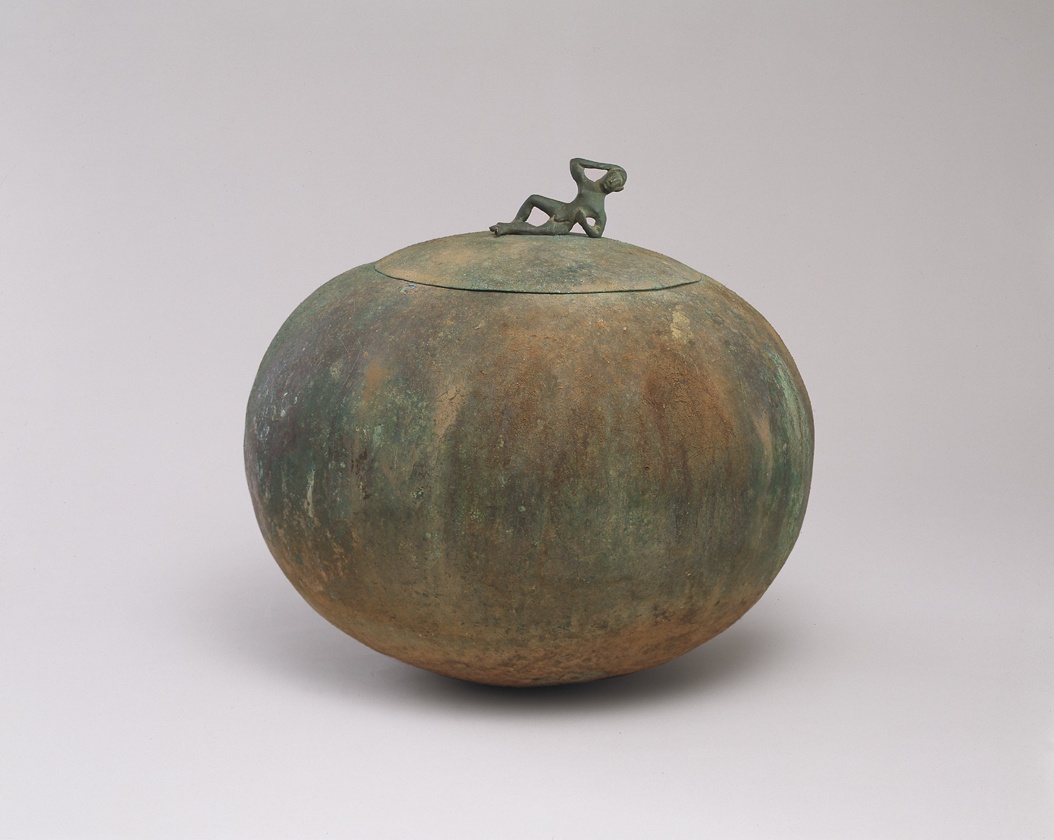
Bronze
H: 27.16 cm (includes lid with reclining satyr).
Diam: 35 cm. Thickness lid: 1+ mm; body: 1+ mm.
Satyr: H: 4. 16 cm. L: 7.17 cm
Allegedly from Santa Maria (Capua Vetere)
Etrusco-Campanian from Capua
c. 500 B.C.
The body and lid of hammered bronze sheet; the satyr solid-cast by the lost wax process, stamped, cut, filed and rasped in
the cold.
Condition: patina of urn and lid a dark green to light green with earth deposits around the whole lower section, earth incrustations with traces of cloth, spots of green atacamite [1]. Downward running stains on the body of the vessel probably the result of condensed moisture in the tomb; a very small section of the vessel worn through at the bottom.
Slight traces of soldering on the lid and under the elbow and feet of the satyr.
Patina of satyr green with specks of emerald green and with dark metal showing through in places. Smooth red cuprite patch behind right elbow and on left buttock, and on tip of nose yellow metal showing through. Under the left armpit traces of fibres.
Capua was renowned for its cinerary urns [2], the majority elaborately engraved and surmounted with various types of figures: Scythian archers on horseback, a ram-bearer, the blower of a great horn and other representations [3].
The simplicity of this urn, so appealing to the modern eye, should not mislead us with regard to its position within the output of the period. Its purity derives from its basic craftsmanship for it was not a sophisticated product.
The reclining [4] figure holding his head, of spirited and cursory workmanship, is as though roughly hacked out. The artisan has - from pride in his skill and possibly to compensate for the intentional frugal appearance of urn and figure - hammered the vessel to a most perfect shape.
Notwithstanding this - the alleged find-spot, the genre of this vessel and the execution of some slight details perceptible in the reclining statuette relate it to certain sophisticated creations from Capua.
For example, a few minor details on the imposing lebes in Berlin [5], however inconsequential, such as the hooves of the horses and the lower parts of their hind legs, the way the horn-blower's horn and arms are made, the way his fingers and feet are chisel-struck in the cold, recall the chisel cuttings on our figure, betraying a similar basic approach.
The writer sees him also as having an affinity with certain Chiusine statuettes and Chiusi particularly, among Etruscan centres, influenced Capua.
The purpose of our vessel was to receive the ashes of the deceased. The Etruscan practice was to expose the body of the recently departed in order that his family and relatives might take leave of him. The lying in state could not last for obvious reasons and was followed by the funerary banquet and cremation on a pyre.
Such vessels as ours wrapped in cloth and fitted in specially hollowed-out tufa blocks, which explains the absence of a foot for our urn, have been found in cemeteries near Capua and Suessula in Campania. Some of the more sophisticated examples did have feet or were placed on bronze/iron tripods.
We do not know whether the reclining figure on the lid of the vessel bears a relation to the funerary banquet or whether his hand to his head recalls the deceased and his regret or sorrow at leaving this world.
However the writer, a product of this day and age, likes to see in this ensemble a representation of man in his relation to the cosmos - wherein he is everything and nothing - and wonders whether subconsciously the Etruscan artist did not feel
the same.
Archaeology Glossary
1 Possibly copper carbonate (malachite), analysis
would determine.
2 Richter, G.M.A.: A Bronze Cinerary Urn (Acquisitions of the Metropolitan Museum), AJA 45, 1940, p. 431 ff. - Adam, A.-M.: Bronzes campaniens du Ve siècle avant J.-C. au Cabinet des Médailles, MEFRA 92, 1980-82, pp. 641-679.
3 E.g., Berlin, Antikenmusem. Misc 6216, Misc 7872: Heilmeyer, W.-D.: Antikenmuseum Berlin (Berlin, 1988), nos. 6, 7, p. 213; an elaborate example is an urn in the British Museum GR 1873.8-20.262 with a standing draped woman on the lid and four sirens on the edge (Haynes, S.: Etruscan Bronzes [London, 1985], no. 63, pp. 268-269, 161); and others.
4 For a figure in the same position see Gabrici, E.: MonAnt XXII, 1913, p. 555 fig. 203 (as from E. Stevens's excavation around the 1880s), reprint Mainz 1979. E. Gabrici mentions that vessels such as the present one were destined for the ashes of the deceased. Though very similar, the Stevens statuette is dressed in a short chiton, while the hand rests on the right knee and a row of short curls adorns the forehead. It is possibly from the same workshop as far as can be assessed from the reproduction in the reprint, which is barely legible.
5 Formigli, E., Heilmeyer, W.-D.: Capuaner Aschenurne in Berlin, AA 99, 1984, p. 395 ff.